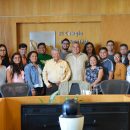BY , AND , PEW RESEARCH CENTER – SEP. 16, 2019
An estimated 36.6 million Hispanics of Mexican origin lived in the United States in 2017, according to a Pew Research Center analysis of the U.S. Census Bureau’s American Community Survey. Mexicans in this statistical profile are people who self-identified as Hispanics of Mexican origin; this includes immigrants from Mexico and those who trace their family ancestry to Mexico.
Mexicans are the largest population of Hispanic origin living in the United States, accounting for 62% of the U.S. Hispanic population in 2017. Since 2000, the Mexican-origin population has increased 76%, growing from 20.9 million to 36.6 million over the period. At the same time, the Mexican foreign-born population living in the U.S. grew by 29%, from 8.7 million in 2000 to 11.2 million in 2017.
Mexican-origin population in the U.S., 2000-2017
The following key facts compare demographic and economic characteristics of the Mexican-origin population in the U.S. with the characteristics of U.S. Hispanics and the U.S. population overall. It is based on Pew Research Center tabulations of the 2017 American Community Survey. Key facts include:
Immigration status
- Among Hispanics in the U.S., about 33% are foreign born, compared with 31% of U.S. Mexicans.
- About 50% of foreign-born Mexicans have been in the U.S. for over 20 years, and 31% of foreign-born Mexicans are U.S. citizens.
Educational attainment
- About 16% of U.S. Hispanics ages 25 and older have obtained at least a bachelor’s degree, compared with 12% of Mexicans.
- Among Mexicans ages 25 and older, the U.S. born are more likely than the foreign born to have a bachelor’s degree or higher (17% vs. 7%).
Income
- Among U.S. Hispanics and Mexicans, the median annual personal earnings for those ages 16 and older was $25,000.
- Looking at full-time, year-round workers, U.S. Hispanics earned $34,000, while Mexicans earned $32,000.
Poverty status
- The share of U.S. Hispanics who live in poverty is 19%, compared with 20% for Mexicans.
- About 20% of U.S.-born Mexicans live in poverty, as do 19% of foreign-born Mexicans.
Homeownership
- The rate of homeownership among U.S. Hispanics is 47%, compared with 50% for Mexicans.
- Among Mexicans in the U.S., rates of homeownership are 52% for the U.S. born and 48% for foreign born.
Top states of residence
- The Mexican population is concentrated in California (35%), Texas (26%) and Arizona (5%).
Age
- The median age of U.S. Hispanics (29) is similar to that of Mexicans (27) and lower than that of the U.S. population (38).
Marital status
- U.S. Hispanics ages 18 and older less likely to be married (46%) than Mexicans (48%).
- Among Mexicans ages 18 and older, those who are foreign born are more likely to be married than U.S.-born Mexicans (61% vs. 37%).
Fertility
- Some 7% of U.S. Hispanic women ages 15 to 44 gave birth in the 12 months prior to the July 2017 American Community Survey. That was similar to the rate for Mexican women (7%).
Language
- About 70% of U.S. Hispanics ages 5 and older speak only English at home or speak English at least “very well,” compared with 71% of Mexicans.
- Similarly, 64% of Hispanic adults are English proficient, as are 65% of Mexican adults.
Download the data
Download the Excel sheet with data on Hispanics of Mexican origin in the U.S.
Other U.S. Hispanic fact sheets
- Facts on U.S. Latinos
- Origin group-specific fact sheets:
| • Argentines
• Cubans |
• Guatemalans | • Puerto Ricans |
Methodology
Pew Research Center’s fact sheets on U.S. Latinos and the accompanying blog postexamine the Latino population of the United States overall and by its 15 largest origin groups — Mexicans, Puerto Ricans, Salvadorans, Cubans, Dominicans, Guatemalans, Colombians, Hondurans, Spaniards, Ecuadorians, Peruvians, Nicaraguans, Venezuelans, Argentines and Panamanians. These sheets provide detailed geographic, demographic and economic characteristics for all Latinos and for each Latino origin group. They are based on Pew Research Center tabulations of the U.S. Census Bureau’s 2010, 2015 and 2017 American Community Survey (ACS) and the 2000 U.S. decennial census.
The ACS is the largest household survey in the United States, with a sample of more than 3 million addresses. It covers the topics previously covered in the long form of the decennial census. The ACS is designed to provide estimates of the size and characteristics of the resident population, which includes persons living in households and group quarters. For more details about the ACS, including the sampling strategy and associated error, see the 2010, 2015 or 2017 American Community Survey’s Accuracy Statement provided by the U.S. Census Bureau.
The specific data sources for these fact sheets are the 1% samples of the 2010, 2015 and 2017 American Community Survey (ACS) Integrated Public Use Microdata Series (IPUMS) provided by the University of Minnesota and the 5% sample of the 2000 decennial census. IPUMS assigns uniform codes, to the extent possible, to data collected by the decennial census and the ACS from 1850 to 2017. For more information about IPUMS, including variable definition and sampling error, please visit the “IPUMS Documentation and User Guide.”
Due to differences in the way in which IPUMS and Census Bureau adjust income data and assign poverty status, data provided on these topics might differ from data that are provided by the Census Bureau.
For the purposes of these fact sheets, the foreign born include those persons who identified as naturalized citizens or non-citizens and are living in the 50 states or the District of Columbia. Persons born in Puerto Rico and other outlying territories of the U.S. and who are now living in the 50 states or the District of Columbia are included in the U.S.-born population.
BY , AND , PEW RESEARCH CENTER – SEP. 16, 2019








